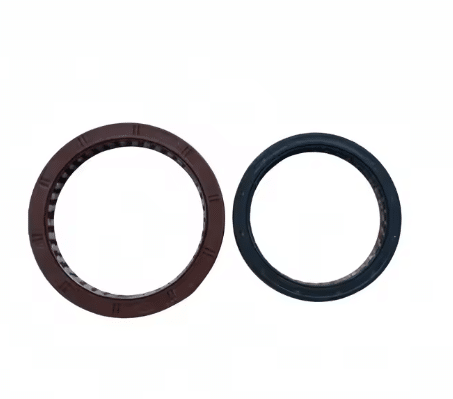Dealing with a rear axle leak can be frustrating, especially when you're unsure which seal to choose. Pick the wrong one, and you'll face another leak in months.
To fix a rear axle leak properly, you must select a seal that matches your axle type, shaft diameter, and operating conditions. Material and lip design also matter for longevity and performance.

The right axle seal saves you from recurring leaks, costly downtime, and frustrated customers or drivers. Let’s explore how to make the right choice with confidence.
What are the symptoms of a rear axle seal leak?
You might first notice oil on your garage floor, or maybe hear a humming noise from the rear.
Rear axle seal leaks typically show signs like fluid around the wheel hub, burning smells, differential noise, or rear brake contamination—especially in drum brake systems.

How do I know if my rear axle seal is leaking?
| 症状 | それが意味するもの | Urgency |
|---|---|---|
| Oil around tire or drum | Seal is leaking | 高い |
| Grinding noise when driving | Fluid is low or gone | Emergency |
| Stains near rear hub | Initial leak forming | 中くらい |
| Burning smell near rear axle | Oil hitting hot brake | 高い |
One of our Southeast Asian customers reported 3 axle failures in a month—until switching to 高品質のオイルシール with dual-lip protection.
Why is choosing the right axle seal important?
Not all axle seals are equal. Wrong fitment, wrong material, or poor lip design = leak again soon.
Axle seals protect your differential oil from escaping and block dust or water from entering. The right seal reduces friction, heat, and long-term failure.

What happens if I choose the wrong rear axle seal?
| Problem | 原因 | Result |
|---|---|---|
| Wrong shaft size | Loose or tight fit | Immediate leak or wear |
| 間違った素材 | Not heat/oil resistant | Early failure |
| Incorrect lip design | Lacks dust/oil seal | 汚染 |
| No OEM match | Tolerance mismatch | 不適切な座席 |
We always advise checking the OEM number or using our oil seal cross-reference chart to avoid mismatch.
What materials are best for rear axle seals?
Material choice is vital, especially for commercial or off-road vehicles. NBR works fine for daily use, while FKM is ideal for heat, pressure, and longevity.
Silicone is more flexible but less abrasion-resistant, and PTFE offers chemical resistance for specialized environments.

Which seal materials should I consider for rear axle applications?
| 材料 | 使用事例 | Pros | Cons |
|---|---|---|---|
| ノンブル | Standard vehicles | Low cost, oil-resistant | Not high-temp |
| フッ化水素 | Heavy-duty, heat | Long life, high temp | Higher price |
| シリコーン | Food grade, soft | Flexible, non-toxic | Weak under abrasion |
| PTFE | Chemicals, pressure | Excellent resistance | Requires special fitment |
私たちは提供する FKM Oリング and oil seals tailored for rear axle loads, ensuring durability even in mining trucks or long-haul fleets.
How to select the right seal size and design for your axle?
Always measure shaft and bore diameters with calipers. Consider lip type: single lip for basic sealing, double lip for dust/oil protection, and triple lip for rugged terrains.
We recommend using OEM reference numbers or working with a supplier like Hengoseal for matching.

What’s the correct way to choose axle seal size and lip style?
| パラメータ | ヒント |
|---|---|
| Shaft diameter | Use vernier caliper |
| Bore/housing size | Check service manual |
| OEM部品番号 | Cross-check databases |
| Lip design | Choose based on contamination level |
| Installation depth | Match original seal specs |
Many clients trust our custom-sized oil seals when OEM parts are discontinued or hard to find.
Can I upgrade my existing rear axle seals?
Absolutely. You can switch from standard NBR single-lip to FKM double-lip or even PTFE for long-lasting performance.
This is especially useful in regions with dust, high heat, or long-haul operations.
When should I consider upgrading rear axle seals?
| シナリオ | おすすめ |
|---|---|
| Frequent seal failures | Upgrade to dual-lip |
| Harsh terrain (dust/mud) | Use triple-lip seals |
| Heat exposure | Choose FKM or PTFE |
| Oil breakdown noticed | Replace fluid & upgrade seal |
| Supply chain issues | Use custom seals ヘンゴシールより |
OEM seal upgrades helped a logistics fleet in Eastern Europe reduce leak-related downtime by 47% in one year.
結論
Rear axle leaks are more than just messy—they’re a risk to vehicle safety and operation. The right seal makes all the difference in cost, durability, and peace of mind.
Seal your axle problems for good—get high-performance seals from Hengoseal
Our oil seals are built for pressure, precision, and performance. OEM quality, fast shipping, and full customization for B2B needs.
📧 メール: [email protected]
📲 WhatsApp: +86 17622979498
Related topic
オイルシールの漏れ:原因、症状、修復方法
TG4 Skeleton Oil Seal | Double Lip Shaft Seal in NBR & FKM
High-Quality Oil Seal | Precision Hydraulic Shaft Seal


